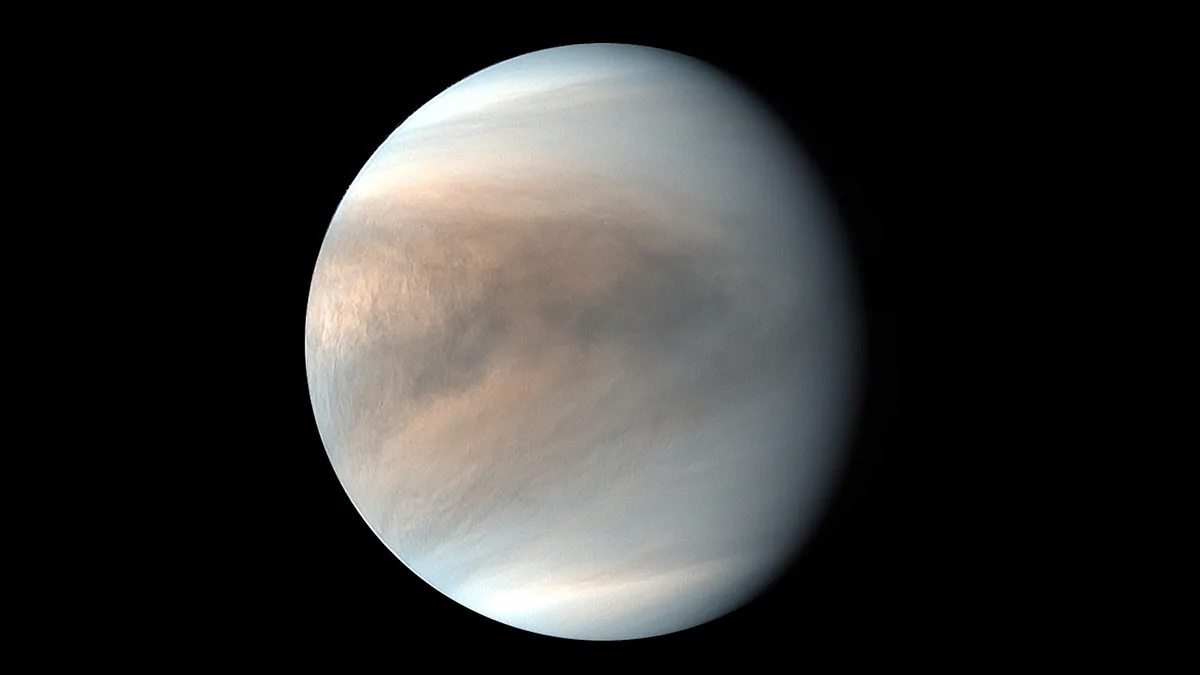17.01.2024
But Venus' skies still remain a possible abode for alien microbes.

The dark markings in Venus' atmosphere — seen here by Japan's Akatsuki spacecraft — are from a UV-absorbing substance. (Image credit: JAXA)
New experiments may have solved one of Venus' biggest mysteries.
Astrochemists have found that iron-bearing minerals are potentially the mysterious ultraviolet-absorbing substance in the clouds that wrap around the ultra-hot second planet from the sun.
When viewed in ultraviolet light, Venus' clouds exhibit dark streaks where something is absorbing those high-energy wavelengths. Over the decades, all manner of explanations for the absorbing substance have been suggested, from ferric chloride to various sulfur compounds and even microorganisms, which is an idea that was first posited in the 1960s by Carl Sagan and still has supporterstoday. However, if the new findings from scientists led by Clancy Zhijian Jiang and Paul Rimmer of the Cavendish Laboratory at the University of Cambridge in England are correct, then they would sideline Venusian life as an explanation, in favor of iron-based chemistry.
Rimmer set the scene in a statement: "The only available data for the composition of the clouds were collected by probes and revealed strange properties of the clouds that so far we have been unable to fully explain. In particular, when examined under ultraviolet light, the Venusian clouds feature a specific UV absorption pattern. What elements, compounds or minerals are responsible for such observation?"
Venus' atmosphere is made primarily from carbon dioxide, but its clouds found at altitudes between 30 and 40 miles (48 to 65 kilometers) above the searingly hot surface are formed from tiny droplets of sulfuric acid, laced with iron-bearing minerals.
Jiang and Rimmer's group synthesized various iron compounds that might exist in Venus' clouds and immersed them in varying concentrations of sulfuric acid. They found that when two of the mineral phases (i.e., compositional variations of a mineral, in this case iron) — rhomboclase and acid ferric sulfate — are combined, they result in an efficient ultraviolet absorber.
"The patterns and level of absorption shown by the combination of these two mineral phases are consistent with the dark UV patches observed in Venusian clouds," said Jiang in the statement. "These targeted experiments revealed the intricate chemical network within the atmosphere, and shed light on the elemental cycling on the Venusian surface."
Given the extent of the UV absorber in Venus' clouds, Jiang and Rimmer's findings strongly suggests that there is significant and unexplored chemistry at work in Venus' clouds. After all, the presence of the UV absorber is more than just a scientific curiosity. The abundance and distribution of the UV absorber changes over time, and previous studies have shown how the variations in ultraviolet albedo — a measure of how reflective or absorptive a planet is — can affect Venus' climate.
Between 2006 and 2017, the amount of solar ultraviolet light reflected back into space by Venus' clouds plummeted by 50% before jumping back up again to previous levels as the abundance of the UV absorber in the clouds changed. The extra UV light that was absorbed helped drive the circulation in the upper atmosphere even faster, energizing the 200-mph (320 kph) winds that power the "super-rotation" in Venus' atmosphere. This is the extreme phenomenon whereby Venus and its upper atmosphere seem decoupled: Venus' solid body spins on its axis once every 243 Earth days, but the upper atmosphere rotates around the planet in just four days.
While the researchers' new finding might disappoint those hoping for Venusian life, the door is still open for microbes on the second planet from the sun. After all, despite Venus' surface being a veritable hellhole with temperatures around 464 degrees Celsius (867 degrees Fahrenheit) and pressures of 93 bar — about 93 times that of Earth at sea level — at the altitude of the clouds, conditions are actually much more clement, with an Earth-like temperature and pressure. Of course, any microbial life in Venus' skies would have to contend with the toxic clouds of sulfuric acid and virtually no water, but recent research has found that amino acids, which are one of the fundamental building blocks of life, can survive the concentrated sulfuric-acid environment. Then there is the puzzlingand contentious detection of phosphine — a gas that on Earth is associated with biology — in Venus' clouds, which remains tantalizing.
Ultimately, the answers to all these questions can be achieved only by returning to Venus with new and daring missions.
NASA intends to launch a mission called DAVINCI ("Deep Atmosphere Venus Investigation of Noble gases, Chemistry and Imaging") in 2029, which will scrutinize Venus' atmosphere by dropping a probe into it, look to confirm the identity of the UV absorber and confirm or rule out the presence of phosphine. A second NASA mission named VERITAS ("Venus Emissivity, Radio Science, InSAR, Topography and Spectroscopy") is awaiting a final ruling on its future after being postponed in 2022 to fund the delayed Psyche asteroid mission.
Meanwhile, the European Space Agency (ESA) is also headed back to Venus with EnVISION, which will launch in the early 2030s to study the planet's atmosphere and geology. (ESA's first mission to the planet, Venus Express, is an 18-year stalwart that is still operational, having launched in November 2005).
The new findings were published on Jan. 3 in the journal Science Advances
Quelle: SC

